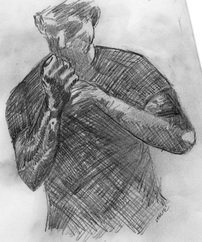My left pinning check to their grabbing hand prevents it from moving into a strike to my face. Meanwhile, I step with my right foot toward them and strike their ribs. The technique uses a middle knuckle fist to further concentrate force to the target (which is great if you have developed this weapon over time but otherwise just use your regular fist) -- my viper snake controls their constrictor snake. This strike isolates their right hand from punching. From there, I pivot my body clockwise and use my right arm to trap their left grabbing arm to my body while my left inward blocking motion on their left shoulder (or slightly below) levers them backward while my left leg sweeps them to the ground as I transition to a forward bow. From here, a series of stomps are used (if needed) to insure my safe retreat.
Lesson One: Strike the central axis to cancel rotation. Although the first strike is delivered to their ribs, because they are to my flank this blow still energetically cuts through their center and limits their ability to rotate (to punch). .
Lesson Two: Strike a target that is pre-stretched. The extension of my attacker's left arm "stretches thin" the muscles of the back and abdominal obliques that help protect the ribs. The middle knuckle strike capitalizes on this exposure.
Lesson Three: Moving the body (support) to the arm instead of the arm to the body. The second movement where we lever against the arm uses the clockwise rotation of our body to bring our support to our right hand trapping their left hand instead of trying to pull our right hand back to our body. This approach is especially useful when dealing with a substantially stronger opponent.
METHODS OF DRILL:
1. Practice the technique on both sides and with the attacker in a variety of positions. Adapt the angle of the initial strike to continue to affect the central axis. Also practice variations where the attacker's arm is less extended, or pushing you away, or pulling you in, or perhaps causing you to rotate.
2. Have your partner attack with a variety of "extended position" grabs and practice strike reacting with strikes to the most exposed target area.
3. Practice adapting the take down and stomping portions of this technique after blocking your partner's roundhouse and straight punch attacks (right and left sides).
4. Have your partner hold a knife in their free hand and explore what changes you would make and why.
5. Condition your middle knuckle strike by punching gently (both sides) into a bucket of pinto beans. Make sure your thumb is properly locking the middle knuckle into position. The volume and power of these punches should be increased gradually over time. Ideally use Dit Da Jow liniment after each training session.
WHAT IS IN A NAME? The middle knuckle potentially can break the rib (crack the cage).

 RSS Feed
RSS Feed